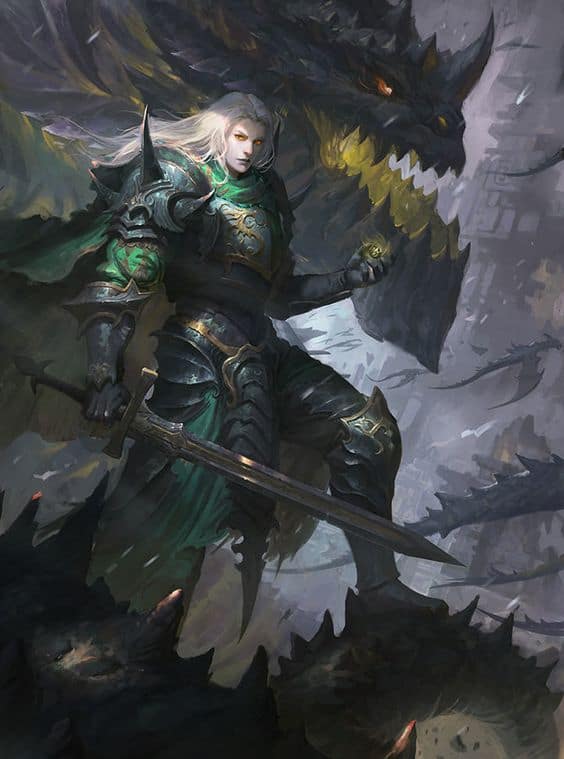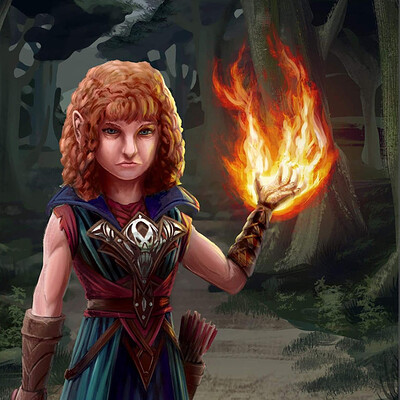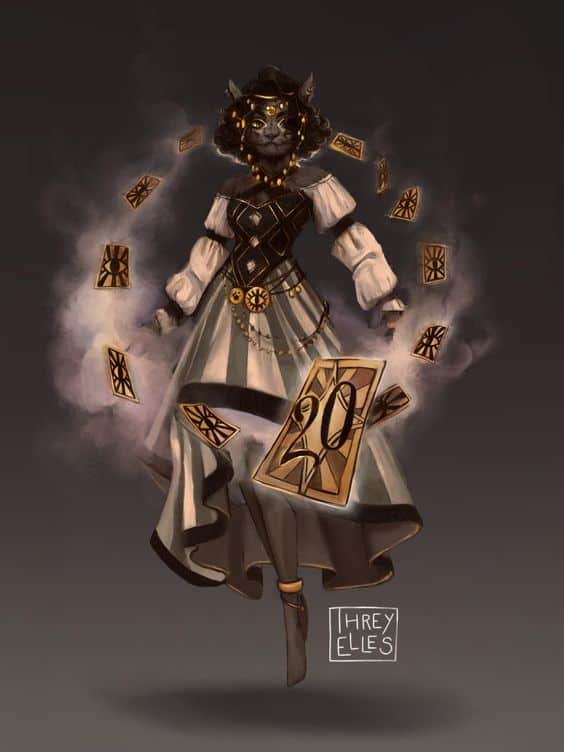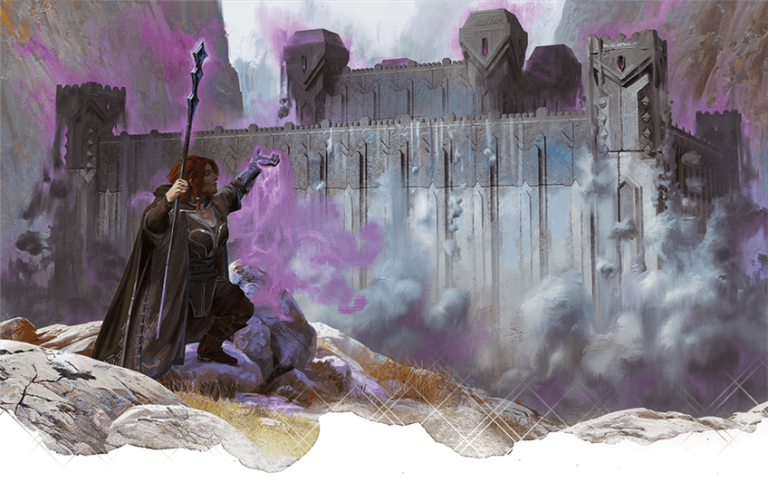D&D 5e: Eldritch Knight Fighter Guide

D&D 5e: Eldritch Knight Fighter Guide
Role in the Party
The party is stuck. Gnolls have fortified a small passing way, and there’s no way out except through. Through the dozen slings and bows, all pointed in their direction. Undeterred, the party’s Fighter rises to her feet, muttering a constant stream of words under her breath. Raising her shield, she steps around the door frame and into the line of fire. Calm. Ready.
A hail of projectiles fills the air, followed a second later by a flaring shield of brilliant energy that wraps around the Knight, turning aside every single bolt and arrow. As the dust settles, she strides forward, completely unharmed and with a smirk on her lips, her allies following in her wake to a certain victory.
Powerful frontline damage dealers and incredibly resilient tanks, the Eldritch Knight is a dedicated martial character who reinforces prowess with weapons with magical force. This guide dives into the strengths of the subclass, effective build paths, feat choices, and more.
Epic
Good
Meh
Bad
The Eldritch Knight Fighter subclass is found in the Player’s Handbook. Click here to pick up your own copy of the Player’s Handbook!
Eldritch Knight Features
Eldritch Knight Spellcasting: The thing that defines the Eldritch Knight is its spellcasting prowess.
The subclass chooses spells from the Wizard spell list, and is a 1/3rd spellcaster, meaning it caps out at level 4 spells, with slow spell progression. Fully 2/3rds of the spells the class knows also have to come from the Abjuration and Evocation schools, meaning defensive and damage spells only.
This isn’t a lot of magical power, but it’s enough. The Fighter base class is one of the most consistent and reliable in the entire game. Every subclass builds on to this in different ways, but the Fighter doesn’t need its subclass options to do its job, they’re just a supplement to the core things it wants to do.
With that in mind, spellcasting choices become much easier. Defensive spells make you harder to kill, and offensive spells let you do things you wouldn’t otherwise be able to, which is deal with groups of enemies or throw out big single target disables.
Weapon Bond: Also at 3, the Eldritch Knight learns to become one with their weapons, so much so that they’re almost a part of each other.
With a one hour ritual, an Eldritch Knight can create a weapon bond, and they can be bonded with up to two weapons at once.
This has two advantages. You can’t ever be disarmed of a bonded weapon (which is nice, but unlikely to ever come up) and you can summon one of your bonded weapons to your hand as a bonus action as long as you’re both on the same plane of existence.
Realistically, this is a ribbon. It’s unlikely to have much mechanical effect on your campaign, but it’s a nice, fluffy ability to have available.
War Magic: From 7th level, whenever the character casts a cantrip, they can make a single attack as a bonus action.
This is really nice. Shocking Grasp, Booming Blade, Lightning Lure, Blade Ward, all now trigger an extra attack roll. Even though it might not be used every turn, overall, this is a solid boost in both damage and utility.
Eldritch Strike: From 10th level, every time you hit a creature with a weapon attack, it has Disadvantage on its saves against your next spell as long as it’s cast before your next turn.
This is incredible. The Eldritch Knight won’t have the highest spell DCs, so conferring Disadvantage goes a long way towards making spells stick.
A few things are worth pointing out here, too. One, it’s before the end of your next turn, so you could potentially hit multiple enemies on one turn, then drop an AOE that hits all of them on the next, with Disadvantage to every save taken.
Two, Action Surge and War Magic. Attack with a weapon cantrip, which is a weapon attack. Action Surge cast a spell with Disadvantage on the same turn. Then bonus action attack a second time, for Disadvantage on your next spell.
Three, the ability states Disadvantage on spells you cast. Nothing about Eldritch Knight spells. So any spells picked up from other sources, like Multiclassing, also work alongside this ability.
Arcane Charge: At level 15, whenever the Eldritch Knight uses Action Surge, they can choose to teleport to a visible square within 30ft.
The teleport is part of the Action Surge action and can be performed before or after the action itself. Free, powerful mobility on one of the best Fighter class abilities? Yes, please.
Improved War Magic: From level 18, War Magic … improves. Now, whenever the character casts any spell, not just a cantrip, they can make a weapon attack as a bonus action.
Again, this is just free damage, letting the Eldritch Knight do more of the two things it does best. Casting the spells, and hitting the enemies. Is it the most powerful level 18 ability? Absolutely not.
But is it something that’s going to be used turn after turn, and give you a noticeable increase in character effectiveness? Yes. Yes, it really is.
Strengths
Being INVINCIBLE!!
It sounds hyperbolic, but the Eldritch Knight has the capacity to be an absolute menace on the battlefield by focusing on their defense. At level 3, when the subclass comes online, the character could be clanking around with plate and shield plus the defensive fighting style for a base AC of 21, with the option to cast Shield to push that up to a ridiculous 26 for a turn, or cast Absorb Elements instead to halve any incoming elemental damage.
This only scales up as stronger spells come into play, adding more defensive layers, as well as supplementary offensive options.
As the character levels, new abilities make it much easier to deal significant damage, stacking weapon attacks on top of spellcasting, as well as reducing the ability of enemies to resist your biggest spells.
Even without all this, the Eldritch Knight is still a Fighter at heart. That means it doesn’t need its subclass abilities to be effective. It can quite happily sit in the midst of the fight, taking hits and swinging right back, turn after turn after turn.
Outside of combat, the Eldritch Knight has the capacity to be a lot more useful than a lot of Fighters are. Magical supplementation, even the simplest things like the Prestidigitation and Minor Illusion cantrips, offers ways to interact with things that aren’t stabbing. Skills bolster this, and if you find a way to pick up ritual casting through Feats or Multiclassing, there’s a lot that the character can do.
Weaknesses
One of the common issues with the Eldritch Knight is a player problem, rather than a class problem. People look at the subclass and think that it’s a mix of spellcaster and martial, rather than a martial character with some spellcasting flavor.
At its heart, the Eldritch Knight is still a Fighter. That means spellcasting is going to be the exception, and not the rule, and what spells you do cast are more likely to be defensive, reflexive buffs, instead of big, flashy AOE blasts. Instead, the Eldritch Knight is going to be in the thick of things, hitting stuff with weapons, just like most fighters.
That’s fine, by the way. It just means that this isn’t the subclass to come to if you want to mix Fireballs with sword swinging. (Look at Hexblade Warlock, some sort of Bard, or just multiclass into Wizard if you want that…)
The other major issue is spell progression. Yes, the Eldritch Knight has spellcasting. No, it doesn’t have much of it, and it’s very easy to run out of spells on longer adventuring days. Unlike many Fighters, the character’s ability doesn’t refresh until you long rest, so resource management becomes especially important to pay attention to.
Best Race Options
Metallic Dragonborn: Ignore AOE spells, embrace AOE dragon breath instead. Going Dragonborn firstly gives you your choice of stats and a damage resistance, both of which are good.
But we’re here for the scaling AOE damage, including a once-per-day stun breath weapon. These breath weapons directly replace a single attack roll and add a way for the class to burn groups of weaker foes, without burning spell slots. That means you can focus even more on defense, and use your racial features to deal with all the most irritating enemies, like swarms.
High Elf: Great stats, Perception proficiency, the weird Elven sleep thing, plus a free Wizard cantrip that uses INT as its casting stat. You only have two cantrips until level 10, so this is 50% more cantrips known for most of an adventuring career.
Githyanki: Flawless stats, a language, and a tool proficiency, as well as some spellcasting. Mage Hand is good to have, and access to the Jump and Misty Step spells, as well as being able to cast them with your spell slots, is just fantastic mobility.
Choosing the Right Skills
You’re a Fighter. Skills aren’t your forte.
You’re probably going to want Athletics and Perception, as they’re skills the character is just going to use.
Things like Stealth and Survival can be handy, especially if your background or character idea fits them.
Near uniquely, the Eldritch Knight can be great at knowledge skills, too. Arcana makes perfect sense, as it’s the ‘magic’ skill. But all of the others will work with your INT to actually give you positive bonuses on the roll.
Fitting Feats
Sentinel: As an Eldritch Knight, your plan is probably to get right in the enemy’s face to try and lock them down and force them to hit you.
Nothing in the game does that better than the Sentinel feat. Suddenly, there’s no way for enemies to avoid taking your opportunity attacks, and if you hit them with one, their speed becomes 0. That forces them to stand right in front of you, and as we’ve already discussed, that’s a very bad option for a lot of enemies.
Sentinel also lets you swing at enemies who have the temerity of attacking friends that are close by, meaning that there are no good choices. If you’re ever stuck on which feat to take, take Sentinel. It won’t let you down.
War Caster: A lot of what the Eldritch Knight will be casting is defensive or offensive buffs that require concentration, so Advantage on those checks goes a long way towards keeping them up and running.
Getting to make opportunity attacks using cantrips (like Booming Blade…) is just the icing on the cake.
Heavy Armor Master: You’re probably wearing some sort of Heavy Armor, and reducing enemy damage is a massive buff to your defenses.
If you can grab this early on using something like Variant Human, it’s almost overpowered, because it cuts the average damage of CR1 monsters by up to 50%. Even in later levels, the damage reduction adds up, especially over a long adventuring day where you might take a dozen or more successful hits.
Optimal Backgrounds
Urchin: Sleight of Hand and Stealth both use DEX, which you can spec into. A Disguise Kit and Thief’s Tools are both incredibly handy things to have on offer too, especially if your party doesn’t have them.
Sailor: Two exceptional skills, as well as Navigator’s Tools and Water Vehicles, are all useful things that slot neatly into the class.
Sage: Intelligence skills, which you can be good at! Plus twin languages if you wanted to be more of a Face. Or understand ancient magical texts. Your choice.
Multiclassing Options
War Magic Wizard: All wizards are solid multiclass options for the Eldritch Knight, offering spell choices and slots, plus ritual casting and other bonuses. The increased spell power is obviously a huge draw. Splitting levels between Fighter and Wizard can more than double the casting power of the class.
But we really want War Caster for its budget ‘Shield’ effect that gives you +2 to AC or +4 to a saving throw as a reaction, all for the price of not being able to use any spells that aren’t cantrips for a turn. Oh no. That means you’ll just have to hit things instead. Which you were probably going to do anyway.
Peace Cleric: The Cleric of Peace makes it into another multiclassing list…
You need at least 13 WIS to take this, which means the character might have a weird stat spread, but the payoff is more than worth it. Access to the Cleric spell list gives you more cantrips, including Guidance, as well as some of the staple Clerical 1st level spells like Healing Word and Shield of Faith.
But what we’re here for is Emboldening Bond, which is in the running for the most potent ability in the game, and only requires a single level of Cleric to be 100% effective.
It’s essentially a 10 minute version of the Bless spell, except it scales in the number of uses and amount of targets with proficiency level. So this multiclass only gets stronger and stronger as you level up. All for one level in Cleric.
Conquest Paladin: A more offensively minded option, taking Paladin levels keeps the spell progression ticking, and offers up some incidental healing, access to the Paladin spell list, which has some excellent options the Eldritch knight doesn’t get, and another fighting style.
The biggest bonus, though, is Smite, which turns spell slots into big bursts of direct damage. Is it the most efficient use of your spells? Not all the time, no. But having the ability to Action Surge into potentially 4 fully powered smites is a good way to make something dead.
Conquest offers the nicest buffs, if you take at least 3 levels in Paladin, including an AOE fear burst, or a flat +10 to hit on an attack roll.
Would I recommend playing an Eldritch Knight Fighter?
The Eldritch Knight is, and probably always will be, the principal gish in D&D. It mixes weapon use and spellcasting to deadly effect, and can be built to be tanky, deal damage, or somewhere in between.
It’s a powerful subclass and built right, can be one of the hardest to kill characters in the entire game, while still capable of being a consistent damage dealer. Even better, the subclass is flexible enough to glue into many different types of builds and can be multiclassed into more than half the classes in the game without issue.
But the real test is always at the table, and the first time your EK shrugs off an entire round of enemy attacks without problems, you’ll understand why people love the class so much.









